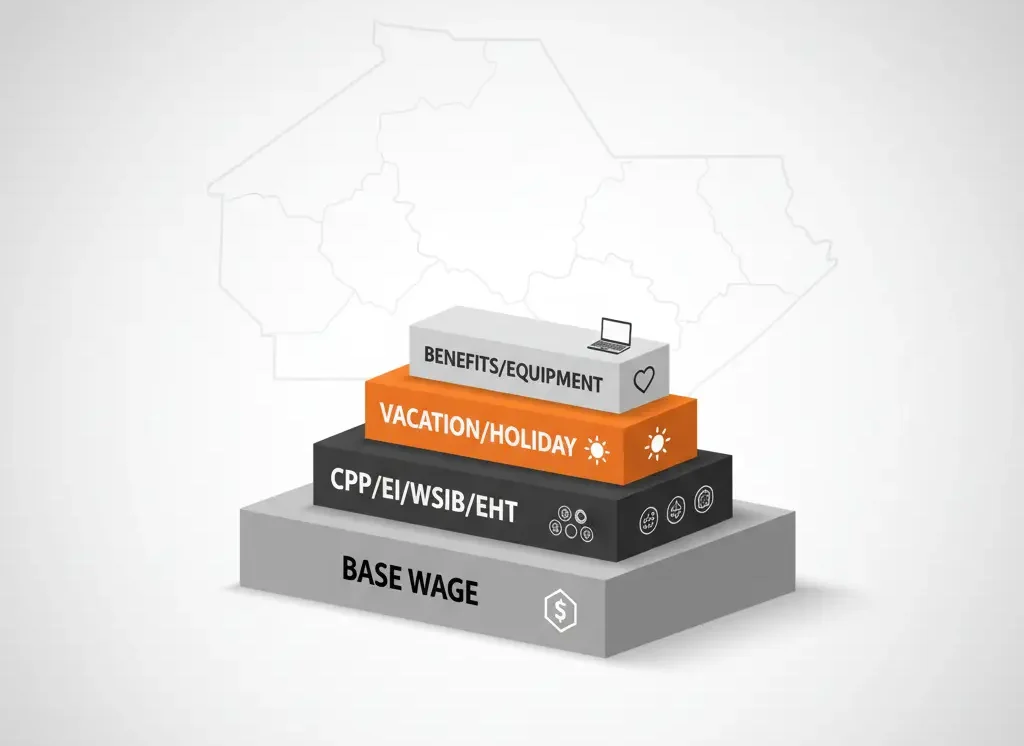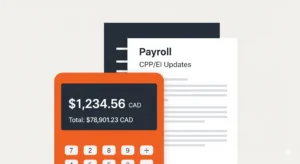If you’re budgeting new headcount, you need the full picture—not just the hourly rate or salary. The cost to hire a worker in Ontario includes wages, statutory contributions (CPP, EI), workplace insurance (WSIB), potential Employer Health Tax (EHT), vacation and public holiday pay, and the “hidden” but very real costs of onboarding, training, turnover, tools, benefits, and compliance. Below, we break it all down using current 2025 numbers and plain-English examples Ontario employers can actually budget with.
The Building Blocks of Employer Cost in Ontario
When you hire in Ontario, your employer cost typically includes:
- Base pay
Hourly wage or annual salary (e.g., $20/hour or $70,000/year). Note that Ontario’s general minimum wage rose to $17.60/hour on October 1, 2025. If you hire entry-level roles, your floor likely moved. - CPP contributions (employer portion)
For 2025, employers contribute 5.95% on pensionable earnings up to the YMPE $71,300, less the $3,500 basic exemption. In addition, CPP2 applies at 4.00% on earnings between $71,300 and $81,200 (the YAMPE). Many small and mid-salary roles won’t hit CPP2, but you should know where the thresholds sit. - EI premiums (employer portion)
Employers pay 1.4× the employee EI rate. For 2025 outside Quebec, the employee rate is 1.64% up to the Maximum Insurable Earnings (MIE) $65,700—so your employer maximum is $1,508.47 per employee. - WSIB premiums
WSIB premiums vary by class, but the average 2025 premium rate is $1.25 per $100 of insurable payroll. Your actual rate depends on your classification and claims performance. - Employer Health Tax (EHT)
If you’re eligible, the first $1,000,000 of Ontario remuneration is exempt from EHT (through 2028). Associated employers share one exemption; groups above $5M payroll generally aren’t eligible. Rates apply once you exceed the exemption. - Vacation pay and public holiday pay
Most Ontario employees earn at least 2 weeks’ vacation (4% vacation pay) until they reach 5 years’ service (then 3 weeks/6%). Ontario has nine public holidays with specific pay rules: if you close on those days, you may still be paying, even with no output. - Benefits & “hidden” costs
Extended health/dental, RRSP match, uniforms/PPE, onboarding/training time, supervisory load, equipment/subscriptions, health & safety programs, policy development, and compliance updates (e.g., pay transparency, disconnect policies) all add up. For context on current HR changes, see our recent updates on pay transparency rules and right to disconnect proposals.
Quick Reality Check: Minimum Wage and Payroll Ceilings for 2025
- Minimum wage: $17.60/hour (since Oct 1, 2025).
- CPP: 5.95% up to YMPE $71,300; CPP2 at 4% on earnings $71,300–$81,200.
- EI: Employee 1.64% up to $65,700; employer is 1.4× employee share (max $1,508.47).
- WSIB: Average $1.25 per $100 of payroll (class-specific rates vary).
- EHT: $1,000,000 annual exemption for eligible employers through 2028.
Example 1: Hiring a Full-Time Hourly Employee at $20/hour
Assumptions: 40 hours/week × 52 weeks = 2,080 hours → $41,600 annual wages.
- Employer CPP (2025): 5.95% × (41,600 − 3,500) = $2,266.95
- Employer EI (2025): 1.4 × 1.64% × $41,600 = $955.14 (well below the annual max)
- WSIB (avg): $1.25 per $100 of payroll → 1.25 × (41,600 ÷ 100) = $520.00
- EHT: $0 (below the $1M exemption, assuming eligible)
- Vacation (minimum 4%): $1,664.00 (if paid on top of hourly wages rather than by paid time off)
- Public holidays (illustrative): If you close and pay 9 statutory holidays with no output, that’s roughly 3.46% of working days—about $1,440 in wages for the year (actual ESA holiday pay formula applies per employee).
What that looks like in dollars:
- Core statutory on-costs (CPP+EI+WSIB): ≈ $3,742 (~9.0% of wages)
- Add vacation minimum (4%): ≈ $5,406 total (~13.0% of wages)
- Add illustrative holiday wages: ≈ $6,846 total (~16.5% of wages)
So, a $20/hour hire can easily cost ~9–16% more than base wages before any benefits, PPE, training time, or turnover risk.
Pro tip: If your hourly roles include paid time off (i.e., you don’t pay vacation “on top”), don’t double-count vacation pay. Structure your policy clearly in your offer letters and handbook.
For a deeper dive on payroll updates hitting budgets this year, see our guide to 2025 payroll changes (CPP2 & EI) and our Ontario minimum wage explainer.
Example 2: Hiring a $70,000 Salaried Employee
Assumptions: Standard full-time schedule; salary includes paid vacation (so no 4% top-up).
- Employer CPP (2025): 5.95% × (70,000 − 3,500) = $3,956.75 (no CPP2 at 70k)
- Employer EI (2025): Hits the maximum $1,508.47
- WSIB (avg): 1.25 × (70,000 ÷ 100) = $875.00
- EHT: $0 (assuming you’re under the $1M exemption and eligible)
Statutory on-costs total: ~$6,340 (~9.1% of salary) before benefits, allowances, or equipment.
When does CPP2 kick in?
At salaries over $71,300, contributions continue at 4% only on the slice between $71,300 and $81,200 (2025 YAMPE). That adds up to an extra max $396 from the employer for the year.
Don’t Forget These Often-Missed Costs
- Benefits: Health/dental, paramedical, vision, life, LTD—typically 8–15% of base pay depending on plan richness and participation.
- Onboarding & training: New hires often take 4–12 weeks to reach full productivity; factor the shadowing time of trainers/supervisors.
- Equipment & software: Laptops, uniforms/PPE, phones, licences (payroll, HRIS, scheduling, collaboration).
- Safety & compliance: WSIB reporting, health & safety training, policies (e.g., pay transparency changes and potential right-to-disconnect policy updates), record-keeping, ESA-compliant scheduling and holiday rules. For a quick catch-up, see our posts on Bill 192 / Working for Workers and pay transparency reporting.
EHT: When You’ll Actually Pay It
If your total Ontario remuneration stays within the $1,000,000 exemption, you won’t owe EHT (subject to eligibility). Once you exceed it, tiered rates apply on the amounts above the exemption. If you’re part of an associated group, the group shares just one exemption and must allocate it. Employers over $5M payroll are generally not eligible for the exemption (with different rules for registered charities). If you’re scaling and expect to cross the threshold, add EHT into your budget.
WSIB: Class Rates Matter
We’ve used the average $1.25 per $100 of payroll for sanity-checking, but industry class rates vary (e.g., hospitality saw 2025 reductions; other classes differ). Check your official classification—and your claims performance—before finalising budgets. Good safety programs reduce claims and can keep your rate lower over time.
Compliance Touchpoints That Affect Cost
- Minimum wage changes (annual Oct 1 CPI updates) can ripple through internal pay bands—plan for compression adjustments.
- Public holiday pay follows ESA rules; budget implications depend on your schedule and whether you operate/close on those dates.
- CPP/EI ceilings typically adjust every January—set your payroll system to update automatically to avoid under/over-deductions.
- Emerging HR rules (e.g., pay transparency) may add light admin cost at first but can improve hiring efficiency by attracting the right candidates faster.
For a monthly payroll partner built around Ontario compliance, see our Payroll & Compensation services (priced for SMBs and growth-stage firms).
Budgeting Framework You Can Steal
- Start with base pay (hourly × expected hours or annual salary).
- Layer on statutory costs using current CPP, EI, WSIB, and (if applicable) EHT. Use ceilings and average WSIB if you don’t know your class yet.
- Decide how you handle vacation (paid time off vs. vacation pay “on top”) and model public holiday impacts based on your operating calendar.
- Add benefits & equipment (benchmarks are fine early on; refine once you get quotes).
- Model a low/likely/high scenario so finance isn’t surprised by variance.
- Review quarterly for regulatory updates (Divino’s Insights Hub tracks these changes for Ontario employers).
If you want a plug-and-play version of this in Excel or Google Sheets, our team can share a template during a free consult.
Internal Resources to Go Deeper
- Ontario’s Minimum Wage Is Now $17.60: An Employer’s Guide — practical steps for payroll, scheduling, and communications.
- 2025 Payroll Changes: Your Guide to CPP2 & EI Updates — what changed and how it flows into budgets.
- 2026 EI Rates: What Ontario Employers Need to Know — if you’re modelling 2026 budgets now.
And if you’d rather not carry the compliance burden yourself, explore Employer of Record (EOR) or HR Management & Planning to offload payroll filings, onboarding, and ESA policy upkeep to Divino.
Authoritative References (so your CFO sleeps at night)
- Government of Canada: CPP contribution rates, maximums and exemptions (2025); CPP2/YAMPE guidance.
- Government of Canada: EI premium rates and maximums (2025).
- Ontario WSIB: 2025 average premium rate ($1.25 per $100).
- Government of Ontario: Minimum wage Oct 1, 2025 – $17.60 (official news release).
- Government of Ontario: Employer Health Tax guidance and $1M exemption.
Bottom Line
For most Ontario employers, the real cost to hire lands ~9–16% above base pay before benefits and equipment—higher if you offer richer plans, uniform allowances, or operate in higher-risk WSIB classes. Get your structure right (comp bands, vacation policy, scheduling) and automate payroll deductions to avoid surprises.
Need help budgeting your next hire?
Book a Free Staffing Consultation or Schedule Your HR Planning Call Today via our Payroll & Compensation or HR Management pages. We’ll map your exact costs, set up clean job offers, and keep you compliant—so you can hire with confidence.




